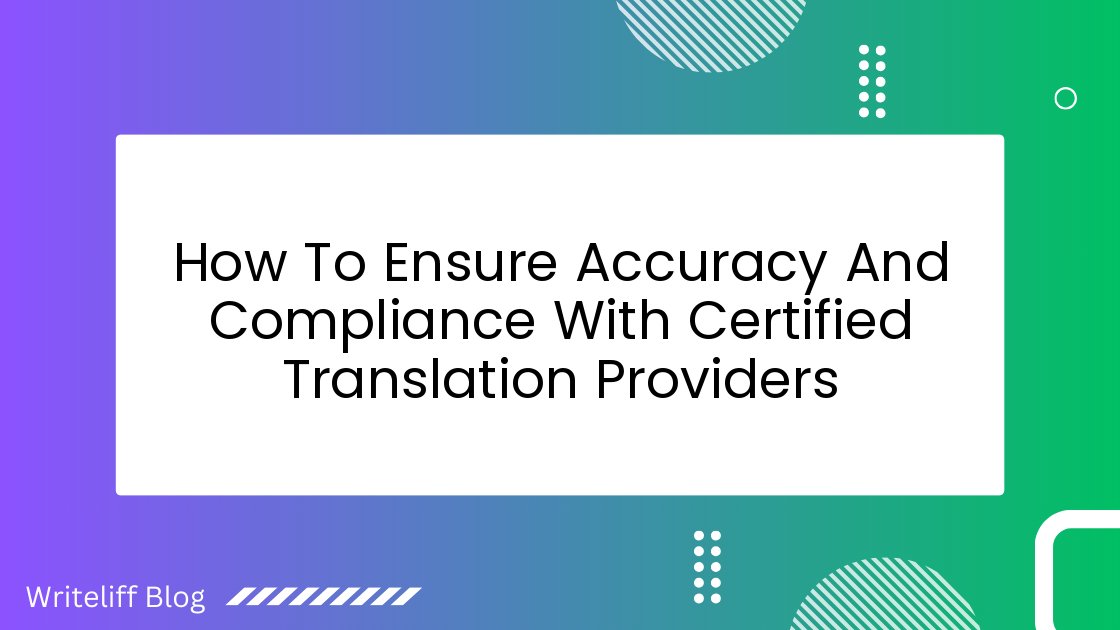How To Ensure Accuracy And Compliance With Certified Translation Providers

Ensuring accuracy and compliance with certified translation providers is crucial in today’s globalized world. Whether you’re dealing with legal documents, medical records, or business contracts, the stakes are high when it comes to translations. Let’s dive into how you can make sure your translations are spot-on and meet all necessary requirements.
Understanding Certified Translations
First things first: what exactly is a certified translation? It’s a translation that comes with a signed statement from the translator or translation company. This statement confirms that the translation is accurate and complete to the best of their knowledge.
Certified translations are often needed for official purposes, like immigration, legal proceedings, or academic applications. They carry more weight than regular translations because they’re guaranteed to be accurate.
Why Accuracy Matters
Accuracy in translations isn’t just about getting the words right. It’s about conveying the exact meaning and intent of the original document. Even a small mistake can have big consequences.
Imagine submitting a mistranslated medical record to a doctor. Or presenting an inaccurate business contract to a potential partner. The results could be disastrous!
That’s why it’s so important to work with reliable, certified translation providers who prioritize accuracy.
Choosing the Right Translation Provider
When it comes to picking a translation provider, you’ve got options. But not all providers are created equal. Here are some things to look for:
- Certification: Make sure they’re certified by a recognized body like the American Translators Association (ATA).
- Experience: Look for providers with a track record in your specific field.
- Quality control: Ask about their review and proofreading processes.
- Technology: Find out what tools they use to ensure consistency and accuracy.
Remember, the cheapest option isn’t always the best. Quality translations are an investment in your success.
The Translation Process
Understanding the translation process can help you ensure accuracy. Here’s a typical workflow:
- Document analysis
- Translation by a qualified professional
- Editing by a second linguist
- Proofreading
- Quality assurance checks
- Final review and certification
Each step is crucial for maintaining accuracy and compliance. Don’t hesitate to ask your provider about their process.
Compliance Considerations
Compliance isn’t just about accuracy. It’s also about meeting specific legal or industry requirements. Different situations call for different compliance measures.
For example, medical translations might need to comply with HIPAA regulations. Legal translations often require notarization. Make sure your provider understands and can meet these specific needs.
It’s always a good idea to check with the receiving authority about their specific requirements. This can save you time and headaches down the road.
Technology and Accuracy
Technology plays a big role in modern translation services. But it’s not about replacing human translators. Instead, it’s about supporting them and improving consistency.
Translation memory tools, for instance, can ensure that repeated phrases are translated the same way throughout a document. Terminology management systems help maintain consistency in technical terms.
Ask your provider about the tools they use. A mix of human expertise and smart technology often yields the best results.
Quality Assurance Measures
Quality assurance (QA) is a critical part of the translation process. It’s what ensures that the final product meets the highest standards of accuracy and compliance.
Good QA processes might include:
- Multiple rounds of review
- Consistency checks
- Formatting checks
- Subject matter expert review
Don’t be shy about asking your provider about their QA processes. The more thorough they are, the more confident you can be in the result.
Handling Sensitive Information
Many certified translations involve sensitive or confidential information. Your translation provider should have strict protocols in place to protect this data.
Look for providers who use secure file transfer methods and have clear confidentiality policies. They should be willing to sign non-disclosure agreements if needed.
Remember, protecting your information is just as important as translating it accurately.
Working with Your Translation Provider
Good communication with your translation provider is key to ensuring accuracy and compliance. Here are some tips:
- Be clear about your needs and expectations from the start
- Provide context for the documents being translated
- Ask questions if you’re unsure about anything
- Give feedback on completed translations
Remember, it’s a partnership. The more information you provide, the better the results will be.
Key Takeaways
Ensuring accuracy and compliance with certified translation providers boils down to a few key points:
- Choose a reputable, certified provider
- Understand the translation process
- Be aware of compliance requirements
- Leverage technology wisely
- Prioritize quality assurance
- Protect sensitive information
- Communicate clearly with your provider
By keeping these points in mind, you’ll be well on your way to getting accurate, compliant translations.
Final Thoughts
Accurate and compliant translations are more than just a nice-to-have. They’re essential for success in many fields, from law to medicine to international business.
While the process might seem daunting, working with the right provider can make all the difference. Our team at Writeliff are here to help. Why not check out our certified document translation service to see how we can meet your needs?
Remember, when it comes to certified translations, accuracy and compliance aren’t just goals – they’re necessities. With the right approach and partner, you can ensure your translations hit the mark every time.
For more information on translation standards and best practices, you might want to check out resources from the American Translators Association or the International Organization for Standardization.